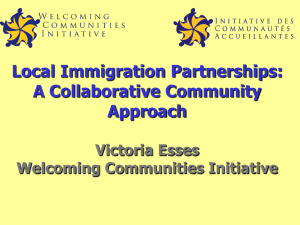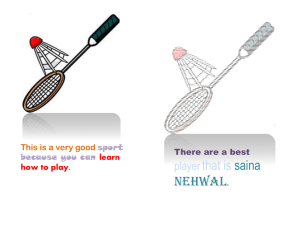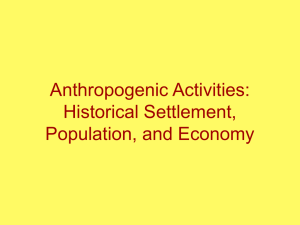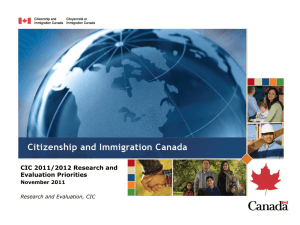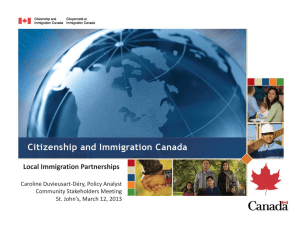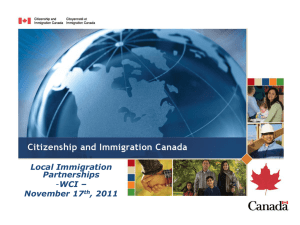Ontario`s LIP Councils: Renewing Multiculturalism from Below?
advertisement
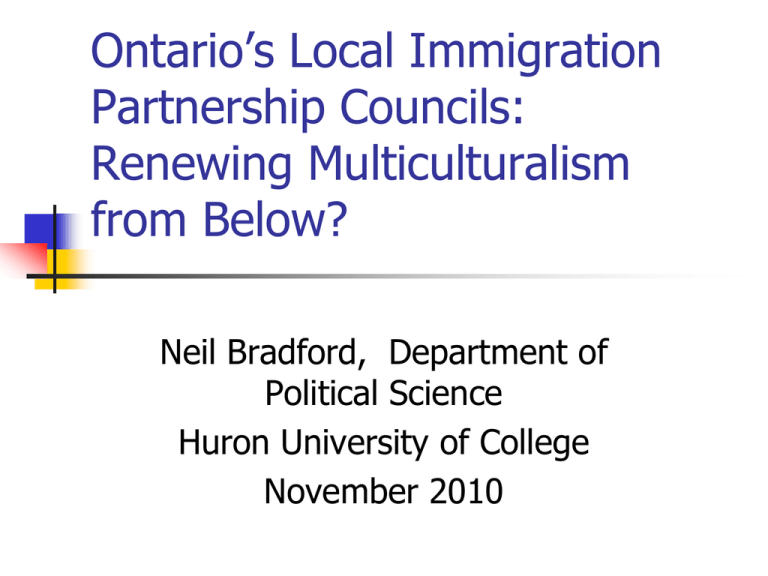
Ontario’s Local Immigration Partnership Councils: Renewing Multiculturalism from Below? Neil Bradford, Department of Political Science Huron University of College November 2010 Presentation Themes Diversity Ideas in Transition: Challenge and Change in Multiculturalism Diversity Ideas Going Local: Federal Devolution in Immigration Policy Diversity Ideas in Practice: Reporting from the LIP front lines Note: the fourth in a series of related MER talks this fall … This presentation builds-off the three previous talks this fall on various aspects of ‘managing Canadian diversity’ 1. 2. 3. L. Tossuti: ideas/theories of multiculturalism D. Tunis: policy/governance of immigrant settlement H. Hussein: practice/partnerships in communities Try to bring these different levels/foci of analysis together … Part 1 Diversity Ideas in Transition: Challenge and Change in Canadian Multiculturalism Canada’s Diversity Model: The Multicultural Pillar 1970s-1980s Canada institutionalized a “Diversity Model” with multiculturalism one key policy pillar (Jenson and Papillon, 2001) Trudeau-Mulroney multicultural nation-building expressed in policy, programs, legislation, constitution (Quebec opt-out) In Practice? Openness to immigration with newcomer integration through combination of timely settlement services reinforced by industrial economy and Keynesian welfare state View multiculturalism as conceptual bridge between immigration policy and settlement/integration programming (note: Department of CIC and Multiculturalism today) A “ national policy success”: immigrant mobility, public support, international recognition (Banting et al. 2010) Challenge and Change: 1990s and 2000s Changing composition of newcomers = complex, specialized needs Industrial restructuring/economic recession hollow out manufacturing sector (entry level employment less available) Keynesian welfare state rationalized making longer term integration more problematic (services less available) Unemployment/underemployment/poverty for recent immigrants Concentration of race and poverty and “Poverty by Postal Code” in large cities; smaller places go without benefits of immigration Fraying bonds of community as “shared spaces and two-way streets” not as vital as once assumed Front line settlement sector stretched thin and mainstream community organizations insufficiently engaged Challenge and Change … Hard questions arise about the multicultural pillar of Canadian Diversity Model … 1. 2. 3. 4. address complex, evolving conditions“on the ground” faced by different newcomers (too top-down)? bridge short term settlement with long term societal integration (too time-limited)? reinforce support for cultural diversity with economic opportunity (too siloed)? balance recognition of difference with cohesion of society (too fragmenting)? CIC’s Deborah Tunis, October 19 2010 UWO talk: “Multiculturalism a successful policy but it’s an evolution and we can’t be trapped in the 1970s” PART 2 Diversity Ideas Going Local: Federal Devolution in Immigration Policy A Diversity Model in Transition Federal governments in 1990s and 2000s respond with two shifts in the national multicultural framework: selection/settlement policy devolution to the provinces (Manitoba, British Columbia), municipalities, and community-based organizations (Ontario) greater emphasis in programs and strategies on anti-racism, promotion of cross-cultural understanding, and supporting involvement of ethnic, religious, cultural communities in public decision making processes Scholarly and settlement communities assess the challenges to the Diversity Model and federal shifts Broad support for the second (anti-racism, cross-cultural, civic engagement) but the first (devolution) controversial Debates and Controversies Scholarly literature identifies four federal motivations/drivers 1. Fiscal: federal deficit and program review lead to off-loading 2. Ideological/Partisan: decentralize social policy in global 3. New Multicultural Policy Knowledge: ‘three stages’ of 4. New Multicultural Conceptual Framework: inter-cultural (Richmond, Laforest) era and ‘new deal’ for cities (Shields and Evans, Leo) settling, integrating, belonging (Mwarigha, Omvidar) communities and localized bridging social capital (Parekh, Landry) Multiculturalism and Devolution: Three Frameworks for Analysis 1. New Localism: Bottom-up Innovation Optimistic Devolvers (focus on factors 3 and 4 on previous slide) beyond top down, centralized bureaucracy, local engagement for new ideas and community-based leadership (Stren and Polese) create local settlement service and civic networks for participatory planning and policy (Sandercock) B. Parekh “Decentralization of power has a particularly important role to play in ensuring justice in multicultural societies. It is easier for local and regional bodies to accommodate differences than it is for the central government, because the adjustment required is more readily identified, limited in scale, not too costly and generally free from the glare of publicity.” ( Rethinking Multiculturalism, 2006: 212) Three Frameworks … 2. Neo-liberalism: Top-down Regulation Pessimistic Devolvers (focus on factors 1 and 2 on previous slide) off- loading state responsibilities to local actors through rigid contractualism that compromises settlement sector and integration processes need to “scale-up” policy to address systemic problems: service underfunding, restrictive eligibility, sector capacity (Keil, Brenner) Tom Kent “Immigration to Canada is in chaos. The federal government’s response to the problems has been to shuffle much of the responsibility to provincial governments and to employers for ostensibly temporary work. In the resulting confusion, the national purpose for immigration is lost. Some easements, such as better settlement services and language upgrading, are widely urged but little is done. At best, they are only band-aids. Fundamental changes are needed.” ( Immigration: For Young Citizens, 2010: 1) Kymlicka: Shifting the Debate Third framework takes it cue from Will Kymlicka: “multicultural states” require “intercultural citizens” to flourish (citizens who support multicultural policies that recognize and accommodate difference) Kymlicka’s concern: a growing gap between the multicultural state and intercultural citizens: “progress at state level not been matched in lived experience of inter-group relations” Three ideas: 1. Citizens must learn and practice their intercultural skills through ongoing dialogue and interaction 2. Local hybrid spaces for joint problem solving between “celebrating food and festivals” and “reconciling deep differences” 3. Feedback loops from local interculturalism to multicultural state Kymlicka effectively reframes the Canadian multicultural policy debate beyond polarized ‘new localism v. neo-liberalism’ to formation of local hybrid institutions Third Framework: New Institutional Hybrids 1. 2. 3. Kymlicka is a philosopher -- doesn’t delve into design and strategy questions From the public administration/organizational design literature we can propose three central features of such new institutional hybrids Interest Representation: Partnership (OECD, 2001) ‘networks of area-based partnerships’ Institutional Design: Metagovernance (Jessop, 2004; Peters, 2010) ‘not just government or governance’ Policy Strategy: Mainstreaming (Torjman, 2007) ‘not just devolution or subsidiarity’ New Institutional Hybrids Metagovernance? “Steering Networks at a Distance”: local autonomy within national parameters Tasks: mandate representation; set goals; build capacity; supply incentives; shared accountability Mainstreaming? “Learning from the local”: local innovations into ‘core’ activities (Smith et al., 2007) Types: 1. Systemic change (policy design eg. settlement linked to housing or health) 2. Programmatic (service delivery eg. one stop shopping or settlement service eligibility) 3. Organizational (planning priorities eg. municipal agencies or corporate mentorships) PART 3 Diversity Ideas in Practice: Reporting from the LIP front lines LIPs as institutional hybrid A variety of cross-fertilizations: 1. 2. 3. 4. 5. 6. 7. 8. Federal Metagovernance and Local Action-Planning Municipal and Community ‘co-production’ Newcomer Representation and Mainstream Organizations Community of Place and Communities of Interest/Identity Economic Development and Social Inclusion Multicultural state and intercultural citizens Community Action and Community Research (WCI relationship: SSHRC and CIC) Tacit knowledge and Public Discourse Other relevant hybrids? Many examples from EU, but Canadian federal government not without its own history: 1. Neighbourhood Renewal (ANC, NIP 1970s) 2. Rural Development (CFDCs 1980s) 3. Urban Poverty (UDAs, VCs, UAS 1990s) 4. Homelessness (SCPI/CHP 2000s) CIC can learn from these examples Bradford (forthcoming) “The Federal Communities Agenda: Metagovernance for Place-based Policy” A New role for Federal Government? COIA emerges in 2005 (NDCC, Harcourt Report) “It is time for a profound transformation in the federal government’s role from being prescriptive, controlling and sectoral to becoming enabling, deft and integrated – and, where relevant, place-based” “The federal government should serve as a leader in ideas and as a convenor and facilitator, bringing people, governments and institutions together to help design solutions to be chosen and applied locally”. “It can offer national resources to convene those closer to communities, facilitate their dialogue and cooperation, and enable solutions through regulatory change and funding” (Harcourt Report, 2006: 21, 22, 29) LIPs: The Roll-Out 2008 CIC call for proposals, 2010 34 LIPs across Ontario CIC Purposes and Parameters: “LIPs will provide a collaborative framework for, and facilitate the development and implementation of, sustainable local and regional solutions for succesful integration of immigrants to Ontario.” CIC CFP identifies four specific objectives and outcomes: 1. 2. 3. 4. Improve access to, and coordination of, effective services Improve access to the labour market Strengthen local and regional awareness and capacity to integrate Establish or enhance partnerships and participation of multiple stakeholders in planning, and coordinating delivery of integration services of both CIC and MCI LIPs: The Roll-Out CIC funding: 1. Establish partnership council that must include wide stakeholders including municipal/regional government, community organizations, settlement agencies employers; council will develop strategic settlement/integration plan including performance measures and evaluation 2. Support partnership council to coordinate implementation of plan (but not specific projects unless in CIC mandate) Three-step process: 1. 2. 3. Establish partnership council/terms of reference Conduct research and establish local settlement strategy to be implemented over 3 years Develop annual action plan and report progress Great expectations … Standing Committee March 2010: “The Committee believes LIPs have great potential. They could bring together diverse parties who might not otherwise collaborate on immigrant settlement. The LIPs provide a vehicle to move collaboration beyond their original purpose”. Government response September 2010: “The principles of the LIPs are in line with government priorities in the Speech from the Throne, namely that the GOC will take steps to support communities in their efforts to tackle local challenges .. LIPS are the best example of existing projects that foster partnerships … LIPs’ efforts have also involved examining needs of immigrants and refugees in order to render mainstream services more responsive”. LIPs as the key legacy from first COIA (context of 2006 settlement funding increase but limited program uptake or evidence of better outcomes) LIPs study (March 2011) Our research approach -- 4 person team through WCI with CIC funding support 1. 2. 3. 4. 5. LIP document analysis (CIC CFPs, council formation,strategic plans, workplans) May 2010 meeting of LIP representatives and policy makers from across province for dialogue on initial progress Fall 2010 series of four semi-structured iterative interviews with key informant from 6 LIPs across provincial regions: Toronto, GTA, Central/Eastern/Northern Ontario, and rural Interview topics: council and partnership formation; strategic planning; workplan implementation; evaluation and learning Our expectation: “Unique local configurations of common elements” Report from the Field: Council and Partnership formation Variation in scale and leadership: Toronto: neighbourhood/settlement sector lead; GTA and beyond: municipal or regional scale/government and mainstream organization lead (eg. United Way, EDC) Prior history of collaboration important factor in LIP council formation (trust and capacity and leadership) General structure features 3 bodies: Steering Committee, Governing Council, Sectoral Working Groups Broad range of stakeholders engaged everywhere and new partnerships eg. school boards, health, and police ‘at the table’ Rural communities mobilizing capacity-building partnerships (eg. Huron LIP with London SPOs and Guelph university researchers) Report from the Field: Strategic Planning Variation in overall focus: Toronto: better settlement via coordination of many existing agencies; GTA and beyond: more attraction via filling gaps (second tier cities) or creating services (rural/north) Common operational priorities: employment, language, settlement, housing, health, justice, participation Public engagement: community fora, focus groups, culturallyappropriate community animators, surveys (“tacit knowledge”) Plans as ‘laundry lists’ (eg. 100 items): need to identify early ‘hits’ (variation across LIPs but not big money initiatives) ‘Mainstreaming’: eg. access to services; links to health and housing; shift corporate priorities in public and private organizations (one LIP has committee on ‘Systemic Change’) Vision of LIPs: not about “eliminating service duplication”; instead about community-driven “social innovation” Report from the Field: Implementation LIPs cannot survive as “all research and talk, no action” Implementation stage challenges: selecting the projects; securing funding; mobilizing the ‘doers’ Some strategies: new Council Terms of Reference; recruit project champions; community ‘declaration of intent’ sign-ups; create ‘funders table’ Initiate 3 year “Planning-Implementation-Evaluation-Adaptation Cycle” across settlement-integration continuum LIP is not the service deliverer nor the funder but the catalyst, convenor,and coordinator (the “social incubator” model ‘spinning out and spinning off’ start-ups) Moving forward? funding challenges key – for strategic plan, for ongoing LIP role, for systemic change (health, housing, employment funding streams with their own criteria) Emerging Themes: Social Learning and Knowledge Transfer Most LIP coordinators initially viewed LIPs as temporary bodies, but two years later see as permanent value-adds Two years of local social capital formation for community capacity Beyond “clever local experiments” to “provincial community of practice” Aggregating experience/practices; Sharing knowledge and successes Applying the EU’s Open Method of Coordination (common template, different pathways, compare results) Emerging Themes: CIC Learns to Metagovern? LIPs experiment a major policy learning opportunity for government (CIC officials and the challenges of “letting go” and being both “partner and funder”) Challenges arising: 1. 1. 2. Funding: Availability, and balancing two legitimate goals: community-driven innovation and federal accountability Steering: Ensuring consistent messages to LIPs on parameters (eg. what’s planning v. implementation?); establish an inter-governmental “stakeholders table” Coordinating: Longer term options for LIP role? (eg. permanent planning arm, OMC best practice network and tools, pilot project vehicle?) Conclusion: Key Takeaways on Theory, Practice, Policy 1. 1. 2. Theory: Renewing Multiculturalism from Below through ‘LIPs at work’ (New Institutional Hybrid better than New Localism v. Neo-liberalism) Local Practice: LIPs at key transition point, moving from Council partnership success to implementation activity (the mainstreaming agenda that demonstrates the value-add) Policy Innovation? Governments learning how to work differently, steer at a distance not command and control (the metagoverning agenda that maintains buy-in to transform experiment into innovation)
